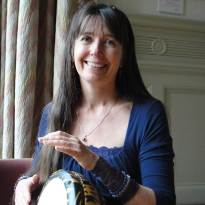 Here in the northern hemisphere, these weeks between Samhain and the winter solstice bring us into the darkest time of the year. In my dance circles, this is my favourite time for candle dances, whose gentle light guides us when we cannot clearly see, while the support of the circle gives us courage to step into the unknown.
Here in the northern hemisphere, these weeks between Samhain and the winter solstice bring us into the darkest time of the year. In my dance circles, this is my favourite time for candle dances, whose gentle light guides us when we cannot clearly see, while the support of the circle gives us courage to step into the unknown.
Dancing with candles is like travelling through time. For thousands of years, dancing in the dark – at night, or deep in caves – took place by the light of the moon or the flame. The beauty of candle dancing is that the darkness is still present; we do not need to disparage it, dispel it, flee it or fight it. This marriage of light and dark comes across in this lovely photo from a recent candle dance at Findhorn.

Winter’s healing dark is nothing to fear. We welcome the beautiful blackness of this time of rest, transcending outdated racist tropes that equate ‘dark’ with ‘bad’. Deep in the womb of the year, when we cannot see to do so much, we can relearn to simply be. Darkness is a sanctuary, a fertile space, to quietly gestate symbolic birth. This peaceful time is the greatest gift, and – if we can receive it – will nurture us just as the rich black earth nurtures the dormant seed.
We all know what it’s like, though, to fall into an unwelcome or unwanted dormancy, through depression or despair, illness or injury, or an unexpected life change. These ‘dark times’ can be very frightening. Even with life changes we have chosen, it still takes courage to go forward when we can’t see what lies ahead.
So it helps, metaphorically, to light a candle and shine a little light into the mysterious, awe-inspiring dark. It is not necessary to fully illuminate the entire situation: we only need a small light, enough to move forward gently, step by step, while still enjoying the beauty of the night.
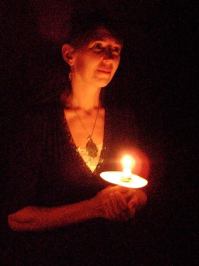
Candle dances give us a chance to experience a safe passage through the places where we cannot see. In my lifelong research into women’s circle dance traditions, I have come across candle dances from all parts of Southeastern Europe and Asia Minor: Armenian, Turkish, Kurdish and Greek. They are also found in northern and western Europe, including Scandinavia, where St Lucia’s Day is celebrated on December 13th with a young woman crowned with a wreath of candles on her head.
Candle dances are often associated with wedding customs. The Thracian dance Knas, still practiced in villages in Northeastern Greece, celebrates the bride on the eve of her wedding. It is danced in darkness, lit only by three burning beeswax tapers in a bowl of henna paste held by the woman leading the line. The bowl is passed to the other dancers in turn and finally to the new bride, welcoming her into the lineage of married women.
Everyone holds a candle in the Armenian wedding dance Mairam Govand, whose song tells the story of a bride named Mairam. ‘They came and took Mairam by night / They took Mairam by candlelight…’ The name Mairam (Mary) is sung over and over, invoking the Divine Mother, just as in ancient times, women on the threshold of marriage invoked the Armenian Goddess Anahit.
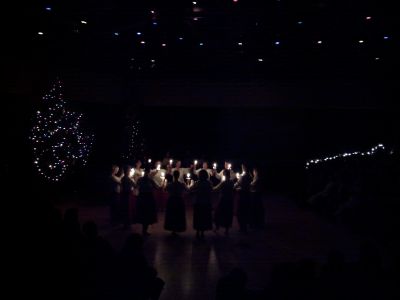
Through this plea for divine blessing and protection, the dance can help everyone present to move through whatever transition she may be facing – for there’s always something new ahead of us, whether we see it clearly or not. Like Sufi poetry, wedding songs such as this one hint at the mystical hieros gamos, the sacred inner marriage which unites all parts of the self in the wholeness of the soul.
The journey of initiation can be seen as a passage through darkness, as in Inanna’s descent to the underworld. In a candle dance, this step over the threshold of change is illuminated, as for the bride in the Armenian song, by the candles we carry. The light of the candle itself is a metaphor for awakened consciousness, which is what will truly keep us safe as we go through the gateways of transformation.
It is wonderful, in these dances, to physically experience how each person’s tiny light adds to and increases the overall illumination of the whole. Miraculously, our individuality and diversity create a healing unity, which for me perfectly illustrates the cooperation and collective action we urgently need to ignite in order to safeguard our planet.
One inspiring example of this miracle was the Circle of Life event led by my Armenian friend Shakeh Tchilingirian, which I mentioned in my post of April 24. In a moving ceremony in commemoration of the Armenian genocide and other atrocities of past 100 years, Shakeh invited Armenians, Turks, Kurds and Assyrians to light candles and dance together for peace and reconciliation.
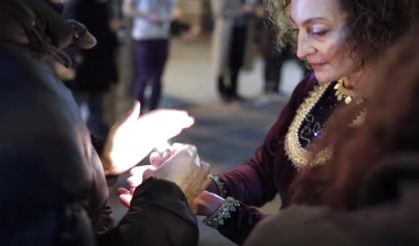
Photo: Hratch Tchilingirian

Photo: Hratch Tchilingirian
As Carol P Christ reminds us in her recent post, the terrible costs and losses of war and exile are a shocking reality we face again now in Europe, especially in Greece, where thousands of refugees arrive daily. Our hearts long for a solution to this catastrophic situation and an end to war.
Yet here is what I have learned on my journeys into the dark: even catastrophes can bring wisdom and healing. Just as precious gems lie deep underground, and seeds only sprout when planted safely in the dark earth, I have discovered valuable gifts and treasures ‘in the dark’ – be it the darkness of physical illness, of depression, of an unknown future, of sudden loss or unexpected change. When we cannot see the way ahead is exactly when we can discover treasures to heal our lives and, through us, the world.
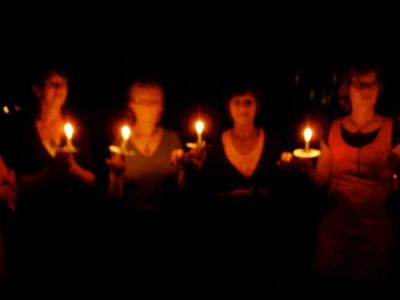
But first we must give ourselves the deep, deep rest which allows the sprouting of the seed, and the deep digging within which uncovers the shining precious gem. This final phase of the yearly cycle is the perfect time for us to do this.
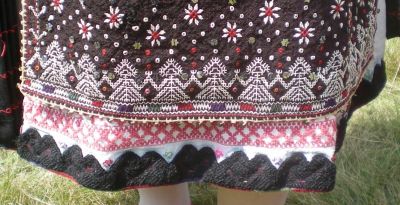
This winter I hope we all may support ourselves and one another to go within, to trust the beautiful blackness of the unseen, and when the time is right, to light a little candle. Not only will this give us support to walk on, but it will strengthen us to help others, who may need guidance even more than we do.
Laura Shannon © 2015
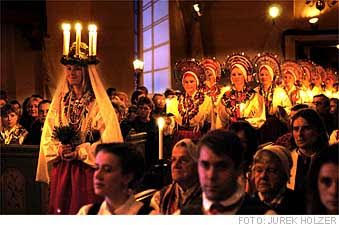
Laura Shannon has been researching and teaching traditional women’s ritual dances since 1987. She is considered one of the ‘grandmothers’ of the worldwide Sacred / Circle Dance movement and gives workshops regularly in over twenty countries worldwide. Laura holds an honours degree in Intercultural Studies (1986) and a diploma in Dance Movement Therapy (1990). She has also dedicated much time to primary research in Balkan and Greek villages, learning songs, dances, rituals and textile patterns which have been passed down for many generations, and which embody an age-old worldview of sustainability, community, and reverence for the earth. Laura’s essay ‘Women’s Ritual Dances: An Ancient Source of Healing in Our Times’, was published in Dancing on the Earth. Laura lives partly in Greece and partly in the Findhorn ecological community in Scotland.


Beautiful photos and exactly what I needed to hear this morning. Thank you so much for writing this.
LikeLike
Yes, gorgeous photos. Thank you, thank you, thank you for explaining the dark is not bad, that black is not evil, that the nighttime of the day or the year is a time of rest and regeneration.
LikeLike
Thank you for this timely and affirming essay!
LikeLike
Another beautiful post. I experience much the same treasure of darkness in the morning and then again in the evening when I walk to and from work in areas of near complete darkness. I have learned to trust that if I mindfully put one foot in front of the other I won’t fall and I can simply enjoy the sense of peace and regeneration you talk about.
LikeLike
Thank you for this beautiful post, Shannon. Candle light is such an integral part of my connection to the sacred. Thank you for this light.
LikeLike
Merci Laura! Je suis toujours heureuse de te retrouver à travers tes posts. Je viens d’experimenter la descente, seule, dans une grotte de Crête (Paiko cave)… Un sentiment unique d’être au plus profond de moi même et de la terre. Mais, la remontée! extraordinaire! Tout était lumière. Chaque brin d’herbe, chaque pierre resplendissait et me disait que notre mère Terre est belle!
Je vais mettre une candle dance au programme de mon prochain atelier et penserai à toi!
Merci encore.
Mylène Henry
LikeLike